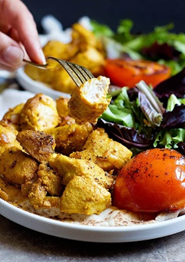Saffron: What Is It and How Do You Use This ‘Red Gold’ Ingredient?
- Digital Marketing
- Jan 17, 2022
- 3 min read
Updated: Feb 25, 2022
Saffron is one of the core, most important ingredients in Persian food and one of the most expensive spices in the world.
Iran produces approximately 85% of the world’s Saffron, according to the UN Food and Agriculture Organization, which stems from its relatively dry and sunny climate. Saffron comes from the flower Crocus sativus (shown below) and is harvested from its red and orange stigmas.

The crocus flower only blooms for two weeks every year, and harvesting the plant takes a tremendous amount of time and energy, hence its high price. The flowers must be harvested by hand either before or after sunrise so that they are not damaged from the sun's heat. Since each flower only has three stigmas, many flowers are needed to produce even the smallest bit of spice.
It is said to take farmers 40 hours to handpick enough stamens to produce a single pound of saffron.
How Saffron is made: Award-winning Iranian-American TV chef Ariana Bundy reveals where saffron comes from, how it is collected and what the different varieties are and products you can buy.
According to National Geographic, Saffron has been used historically to treat everything from heartache to hemorrhoids by traditional healers. The ingredient has high levels of antioxidants that help with inflammation in the body. Additionally, there is growing evidence that saffron may help improve mood and be a useful addition to treatment for depression.
In the Iranian kitchen, however, Saffron is a staple that is infused in a wide range of dishes for its distinguished color and aroma. Only a small amount is needed to really flavor and enrich a dish. With its high cost, it is extremely important to stretch Saffron to make it financially feasible. Cooks tend to grind the threads of the flower with a small pinch of sugar and salt to create fiction and yield a fine powder. This is generally done using a pestle and mortar. Once grounded, the powder is then added to a small amount of hot water and steeped for a few minutes. Once formed into a concentrated liquid, you can then add it to dishes or use it as a marinade for meats or vegetables.
Saffron is a key component to Persian cuisine and the Iranian culture. The ritual of preparing it respects tradition and history passed down from generation to generation. It is a beloved ingredient that all should try. Below are some Persian dishes, that include Saffron, that will get your taste buds moving! Be sure to check them out!
Persian Saffron Rice
Joojeh Persian Saffron Chicken Kebab
Caution: Look out for fake Saffron in the market!
Unfortunately, there are sellers in the market who try to capitalize on the high price of saffron by providing low-quality or fake saffron. Be sure to research and test your saffron to know if you are truly getting a good quality product!
Here are a 3 quick tips on how to tell if your saffron is good quality or not:
Place a few saffron threads in cold water - pure saffron will release a golden color slowly over 10-15 minutes. Altered saffron will release a deep red color.
Rub the saffron threads with your fingers - if they fall apart, your product is altered, as real saffron will not break apart.
Taste it - if it tastes sweet, your saffron is altered - real saffron has a bitter taste.


Comments